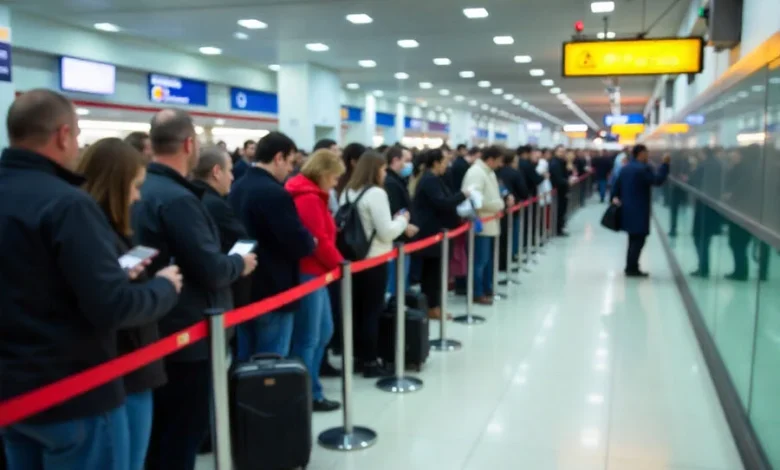South Korea Joins China And Taiwan In Causing A Drop In Travel And Passenger Numbers At Macau Airport In Third Quarter Of 2025

Published on
October 29, 2025
South Korea joins China and Taiwan in causing a drop in travel and passenger numbers at Macau International Airport in the third quarter of 2025, as the region faces a decline in arrivals primarily from mainland China. This downturn, marked by an overall 6.3% decrease in passenger traffic, was further impacted by fewer mainland Chinese travelers, the airport’s largest source market. While Taiwan and South Korea showed growth, the drop in Chinese visitors has been significant, highlighting the ongoing challenges in Macau’s recovery from the pandemic, despite targeted efforts to attract travelers from other regions.
Macau International Airport (MIA) faced a challenging third quarter in 2025, with a notable decline in passenger numbers. While the global aviation industry has been making strides toward recovery, MIA experienced a 6.3% decrease in passenger traffic in the third quarter, compared to the same period in 2024. This drop was mainly attributed to fewer arrivals from mainland China, the airport’s largest source market, as well as diminished contributions from other key regions, including South Korea and Taiwan.
The Decline in Passenger Numbers: A Breakdown
During the third quarter, MIA handled 1.89 million passengers, a significant reduction from the 2 million passengers in the same period in 2024. This 6.3% decline starkly contrasts with the broader recovery seen across other parts of the world, where global airports have been experiencing steady growth in passenger traffic. Despite the overall reduction, September showed signs of recovery with a 3.9% year-on-year increase in passengers, reaching 555,730, which helped partially offset the significant declines witnessed in July and August.
The total traffic for the first nine months of 2025 reached nearly 5.5 million passengers, which was 4.3% lower than the same period in 2024. This represented about 76% of the pre-pandemic traffic level from 2019, highlighting that while Macau’s tourism sector is slowly recovering, it has not yet reached the levels of passenger traffic seen before the COVID-19 pandemic.
Mainland China’s Impact on Macau Airport Traffic
Mainland China, which has traditionally been the dominant source of international visitors to Macau, experienced a sharp decline in passenger traffic to the airport. Arrivals from mainland China dropped by 8.3% to 1.45 million, a significant dip in comparison to 2024. This reduction can be attributed to several factors, including slower economic recovery, reduced demand for leisure travel, and increased operational costs for airlines. The declining numbers from mainland China, the largest market for Macau, have played a central role in the downturn of airport traffic.
This decline comes in the context of the changing landscape of travel in China, where consumer behavior has shifted, and more Chinese tourists are opting for alternative destinations. The once-favored travel routes between Macau and mainland Chinese cities saw fewer passengers, reflecting the evolving travel habits post-pandemic.
South Korea’s Growing Influence on Macau’s Tourism
While the decline from mainland China has been significant, the role of South Korea in shaping Macau’s tourism recovery is notable. In contrast to China’s decline, South Korean arrivals have shown positive growth. During the third quarter of 2025, Korean arrivals to Macau rose by 12% year-on-year, reaching 382,494 passengers. This increase indicates that despite the overall decline in passenger traffic, South Korea remains a crucial market for Macau’s tourism sector.
To build on this positive trend, the Macao Government Tourism Office (MGTO) launched the “KB Kookmin Travelers Check Card – Macao Edition.” This initiative, which is a collaboration with KB Kookmin Card and Mastercard Korea, offers exclusive discounts on Macau tourism products for Korean travelers. The card provides benefits for various aspects of travel, including flights, hotels, dining, and entertainment, especially residency shows. This targeted marketing effort seeks to attract more Korean visitors to Macau by offering them a variety of incentives that enhance their travel experience.
The partnership with KB Kookmin Card includes the distribution of special physical cards featuring iconic Macau landmarks, designed to appeal to both Korean travelers and the wider international audience. In addition to card promotions, there were online campaigns and media collaborations aimed at attracting younger demographics, such as Millennials and Gen Z. These efforts highlight the importance of maintaining and expanding relationships with key markets like South Korea as Macau works to recover from its overall traffic decline.
Taiwan’s Role in Macau Airport’s Recovery Efforts
Taiwan, another critical market for Macau, has also played a role in the airport’s fluctuating traffic numbers. Despite the broader drop in passenger arrivals, Taiwan saw a notable 10.3% increase in arrivals to Macau in the first nine months of 2025. This growth stands in stark contrast to the downward trend from mainland China, emphasizing the diversification of Macau’s tourism base and the effectiveness of its marketing strategies in other regions.
Taiwan has long been one of Macau’s top tourist markets, contributing significantly to the airport’s passenger numbers. The boost in Taiwanese arrivals indicates that Macau’s tourism and airport authorities are successfully engaging with alternative markets, compensating for some of the losses from mainland China. As Taiwan continues to grow as a market for Macau, it provides a welcome source of stability for the airport’s operations.
The Macao Government Tourism Office’s Strategic Response
In response to the challenges posed by the declining numbers from mainland China, the MGTO has increased its efforts to diversify the regions from which visitors come. While mainland China has been the mainstay of Macau’s tourist traffic, the growing significance of markets like South Korea and Taiwan has prompted Macau’s tourism authorities to intensify their marketing strategies in these areas.
Beyond the initiatives targeting Korean travelers, the MGTO has also increased its focus on promoting Macau as a destination for family-oriented travel and luxury tourism. With these strategic shifts, the government aims to maintain a diverse and resilient tourism industry, even as it faces a significant reduction in Chinese arrivals.
Impact of Broader Travel Trends
The decline in passenger traffic at Macau International Airport is part of a broader global trend where certain regions are experiencing slower-than-expected recovery in travel. Factors such as ongoing geopolitical uncertainties, economic slowdown in key markets, and increasing operational costs are contributing to a more uneven recovery in air travel across the globe.
In addition to these global challenges, Macau faces competition from other destinations in Asia. Neighboring cities like Hong Kong and Zhuhai, along with regional hubs such as Singapore and Bangkok, continue to attract international visitors with their own unique offerings. Macau’s reliance on a single market for a large proportion of its visitors has shown to be a vulnerability, and the city is taking proactive steps to expand its reach and broaden its tourism appeal.
The Outlook for Macau Airport and Tourism
Despite the challenges faced by Macau International Airport, there is optimism for the future. As global travel continues to recover, Macau is positioning itself to be a more attractive destination for international travelers. The introduction of new promotional campaigns, especially those aimed at younger travelers and specific regional markets, is a positive step forward in restoring the city’s tourism industry.
Moreover, the emphasis on luxury, cultural experiences, and family-friendly attractions could help Macau differentiate itself from its competitors in the region. The ongoing efforts to improve connectivity, expand infrastructure, and enhance the overall visitor experience suggest that Macau is committed to ensuring that its tourism sector remains competitive and resilient in the face of changing global dynamics.
The third quarter of 2025 revealed the delicate balancing act that Macau faces in restoring its tourism and airport traffic. While mainland China, historically the main source of visitors, saw a decline in traffic, regions like South Korea and Taiwan have stepped up as significant contributors to the recovery efforts. The targeted strategies of the Macao Government Tourism Office, including special offers for South Korean travelers and a renewed focus on luxury and family tourism, will play a critical role in shaping the future of Macau’s tourism industry.
As Macau continues to diversify its tourism sources and expand its appeal to a broader global audience, the airport and tourism sector will likely experience a more sustainable recovery. The lessons learned from this period of slower growth will undoubtedly inform future strategies, ensuring that Macau remains a key player in Asia’s vibrant tourism landscape.
South Korea joins China and Taiwan in causing a drop in travel and passenger numbers at Macau International Airport in the third quarter of 2025 due to a significant decline in arrivals from mainland China. This drop has been partially offset by growth in visitors from Taiwan and South Korea, but the overall traffic remains below expectations.
By adapting to shifting travel patterns, focusing on targeted markets, and enhancing the visitor experience, Macau can continue to grow and thrive in the competitive global tourism sector.




